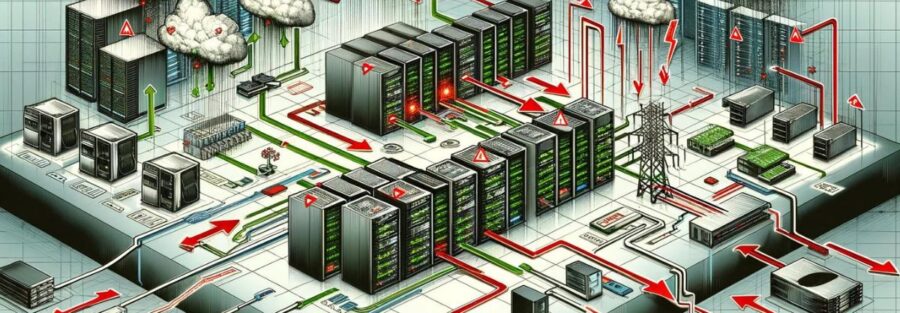Beyond the Push of a Button
Failover mechanisms are crucial for ensuring business continuity during system failures or cyber incidents. However, there is a common misconception among executives that failover is as simple as pushing a button to seamlessly switch to a backup system. The reality is far more complex. This blog post aims to explain the intricacies of failover, the challenges of achieving true failover with data consistency, and how to effectively communicate these complexities to executives.
What is Failover?
Failover refers to the process of automatically switching to a redundant or standby system upon the failure of the primary system. This is intended to ensure continuous availability and minimal disruption to business operations. Failover mechanisms are a critical component of disaster recovery and business continuity plans.
The Executive Perception
Executives often envision failover as a simple process where operations seamlessly continue with no downtime or data loss, akin to flipping a switch. This perception can lead to unrealistic expectations and pushback when the complexities and limitations of failover are explained. It is essential to bridge the gap between executive expectations and the technical realities.
The Reality of Failover
In practice, achieving true failover with data consistency is a complex and challenging process. Several factors contribute to this complexity:
Failover Time
Failover time refers to the duration it takes to switch from the primary system to the standby system. This process is not instantaneous and can involve several steps, including detecting the failure, initiating the failover process, and ensuring all services are up and running on the standby system. The length of failover time can vary depending on the infrastructure and the nature of the failure.
Data Consistency
Maintaining data consistency during failover is one of the most challenging aspects. Data transactions may be in progress when a failure occurs, leading to potential data loss or corruption. Ensuring that the standby system has the most recent and accurate data is crucial but difficult to achieve, especially in environments with high transaction volumes.
Network Latency and Bandwidth
The performance of failover mechanisms is heavily dependent on network latency and bandwidth. High latency or limited bandwidth can slow down data replication and synchronization processes, increasing the risk of data inconsistencies and extended failover times.
Testing and Validation
Regular testing and validation of failover processes are essential to ensure they work as expected. However, testing failover scenarios can be complex and resource-intensive, requiring careful planning and execution to avoid disrupting live operations.
Common Failover Challenges
Several challenges can arise during the failover process, complicating efforts to achieve seamless and consistent failover:
Split-Brain Syndrome
Split-brain syndrome occurs when both the primary and standby systems believe they are the active system, leading to data inconsistencies and potential conflicts. This can happen due to network partitioning or failures in the failover mechanism.
Data Replication Lag
Data replication lag refers to the delay between changes made on the primary system and those changes being reflected on the standby system. This lag can result in the standby system being out of sync with the primary system, causing data inconsistencies during failover.
Manual Intervention
In some cases, manual intervention may be required to complete the failover process, especially if automated mechanisms encounter issues. This can introduce delays and increase the risk of errors.
Resource Constraints
Implementing and maintaining robust failover mechanisms can be resource-intensive, requiring significant investments in infrastructure, software, and skilled personnel. Budget constraints can limit the ability to achieve true failover with data consistency.
Communicating Failover Complexities to Executives
Effectively communicating the complexities of failover to executives is crucial for setting realistic expectations and securing the necessary support and resources. Here are some strategies for achieving this:
Use Analogies and Examples
Analogies and real-world examples can help bridge the gap between technical details and executive understanding. For example, compare failover to switching from a primary power grid to a backup generator, highlighting the time and processes involved in ensuring a seamless transition.
Highlight Business Impact
Emphasize the potential business impact of failover challenges, such as downtime, data loss, and operational disruptions. Provide case studies or examples of organizations that have faced significant consequences due to inadequate failover mechanisms.
Present Data and Metrics
Use data and metrics to illustrate the complexities and challenges of failover. Present information on failover times, data replication lags, and the costs associated with achieving high availability and data consistency.
Outline the Steps and Resources Required
Provide a detailed outline of the steps involved in achieving true failover with data consistency, including the necessary infrastructure, software, and personnel. Highlight the resource and budgetary requirements to set realistic expectations.
Emphasize the Importance of Regular Testing
Stress the importance of regular testing and validation of failover processes. Explain that continuous testing is necessary to ensure failover mechanisms work as expected and to identify and address potential issues before they impact live operations.
Achieving Effective Failover
While achieving true failover with data consistency is challenging, there are strategies and best practices that can help organizations improve their failover capabilities:
Implement Redundant Systems
Implement redundant systems and infrastructure to minimize single points of failure. This includes having multiple data centers, backup power supplies, and redundant network connections.
Use Advanced Data Replication Technologies
Invest in advanced data replication technologies that provide real-time or near-real-time data synchronization. These technologies can help minimize data replication lag and ensure the standby system is up to date.
Automate Failover Processes
Automate failover processes as much as possible to reduce the need for manual intervention. Automated failover mechanisms can detect failures and initiate the failover process quickly and efficiently.
Regularly Test and Validate Failover Mechanisms
Conduct regular testing and validation of failover mechanisms to ensure they work as expected. This includes running simulated failover scenarios, performing disaster recovery drills, and continuously monitoring and improving failover processes.
Monitor and Manage Network Performance
Monitor and manage network performance to ensure low latency and high bandwidth for data replication and failover processes. Address network bottlenecks and issues that could impact failover performance.
Failover is a critical component of any cybersecurity and IT strategy, but it is not as simple as pressing a button. Achieving true failover with data consistency involves complex processes, potential challenges, and significant resource investments. By understanding and communicating these complexities to executives, organizations can set realistic expectations and secure the necessary support for building robust failover mechanisms. Consistent effort, regular testing, and a commitment to continuous improvement are essential for ensuring effective failover and maintaining business continuity in the face of cyber threats and system failures.



